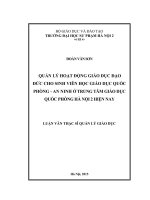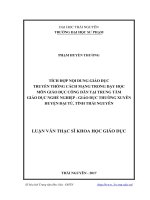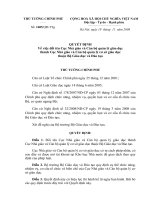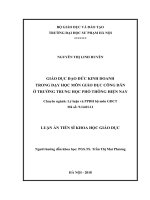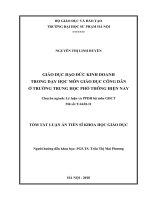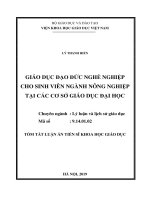past hướng dẫn phần mềm thống kê cổ sinh học dành cho giáo dục và phân tích dữ liệu
Bạn đang xem bản rút gọn của tài liệu. Xem và tải ngay bản đầy đủ của tài liệu tại đây (237.46 KB, 10 trang )
<span class="text_page_counter">Trang 1</span><div class="page_container" data-page="1">
<small>See discussions, stats, and author profiles for this publication at: Paleontological Statistics Software Package for Education and DataAnalysis
<b><small>Article</small></b><small> </small><i><small>in</small></i><small> Palaeontologia Electronica · May 2001</small>
<b><small>3 authors:</small></b>
<b><small>Some of the authors of this publication are also working on these related projects:</small></b>
<small>The Perfect Shape - spiral storiesView project</small>
<small>NORLEXView projectOyvind HammerUniversity of Oslo</small>
<small>All content following this page was uploaded by David A.T. Harper on 08 May 2015.</small>
<small>The user has requested enhancement of the downloaded file.</small>
</div><span class="text_page_counter">Trang 2</span><div class="page_container" data-page="2"><i><b>Palaeontologia Electronica </b></i>
<small>Hammer, Øyvind, Harper, David A.T., and Paul D. Ryan, 2001. Past: Paleontological Statistics Software Package for Education and </small>
<b>PAST: PALEONTOLOGICAL STATISTICS SOFTWARE PACKAGE FOR EDUCATION AND DATA ANALYSIS</b>
<b>Øyvind Hammer, David A.T. Harper, and Paul D. Ryan</b>
<small>Øyvind Hammer. Paleontological Museum, University of Oslo, Sars gate1, 0562 Oslo, Norway </small>
<small>David A. T. Harper. Geological Museum, Øster Voldgade 5-7, University of Copenhagen, DK-1350 hagen K, Denmark</small>
<small>Copen-Paul D. Ryan. Department of Geology, National University of Ireland, Galway, Ireland</small>
<small>A comprehensive, but simple-to-use software package for executing a range ofstandard numerical analysis and operations used in quantitative paleontology hasbeen developed. The program, called PAST (PAleontological STatistics), runs on stan-dard Windows computers and is available free of charge. PAST integrates spread-sheet-type data entry with univariate and multivariate statistics, curve fitting, time-series analysis, data plotting, and simple phylogenetic analysis. Many of the functionsare specific to paleontology and ecology, and these functions are not found in stan-dard, more extensive, statistical packages. PAST also includes fourteen case studies(data files and exercises) illustrating use of the program for paleontological problems,making it a complete educational package for courses in quantitative methods.</small>
<small>KEY WORDS: Software, data analysis, educationCopyright: Palaeontological Association, 22 June 2001Submission: 28 February 2001 Acceptance: 13 May 2001</small>
Even a cursory glance at the recentpaleontological literature should convinceanyone that quantitative methods in pale-ontology have arrived at last. Neverthe-less, many paleontologists still hesitate inapplying such methods to their own data.One of the reasons for this has been thedifficulty in acquiring and using appropri-ate data-analysis software. The ‘PALSTAT’program was developed in the 1980s inorder to minimize such obstacles and pro-
vide students with a coherent, easy-to-usepackage that supported a wide range ofalgorithms while allowing hands-on experi-ence with quantitative methods. The firstPALSTAT version was programmed for the
<i>BBC microcomputer (Harper and Ryan</i>
1987), while later revisions were made forthe PC (Ryan et al. 1995). Incorporatingunivariate and multivariate statistics andother plotting and analytical functions spe-cific to paleontology and ecology, PAL-
</div><span class="text_page_counter">Trang 3</span><div class="page_container" data-page="3"><small>Øyvind Hammer, David A. T. Harper, and Paul D. Ryan: PALEONTOLOGICAL STATISTICS SOFTWARE</small>
<small>2</small>STAT gained a wide user base among
both paleontologists and biologists.
After some years of service, however,it was becoming clear that PALSTAT hadto undergo major revision. The DOS-based user interface and an architecturedesigned for computers with minisculememories (by modern standards) wasbecoming an obstacle for most users.Also, the field of quantitative paleontologyhas changed and expanded considerablyin the last 15 years, requiring the imple-mentation of many new algorithms. There-fore, in 1999 we decided to redesign theprogram totally, keeping the general con-cept but without concern for the originalsource code. The new program, calledPAST (PAleontological STatistics) takesfull advantage of the Windows operatingsystem, with a modern, spreadsheet-based, user interface and extensivegraphics. Most PAST algorithms producegraphical output automatically, and thehigh-quality figures can be printed orpasted into other programs. The function-ality has been extended substantially withinclusion of important algorithms in thestandard PAST toolbox. Functions foundin PAST that were not available in PAL-STAT include (but are not limited to) parsi-mony analysis with cladogram plotting,detrended correspondence analysis, prin-cipal coordinates analysis, time-seriesanalysis (spectral and autocorrelation),geometrical analysis (point distributionand Fourier shape analysis), rarefaction,modelling by nonlinear functions (e.g.,logistic curve, sum-of-sines) and quantita-tive biostratigraphy using the unitary asso-ciations method. We believe that thefunctions we have implemented reflect thepresent practice of paleontological dataanalysis, with the exception of some func-tionality that we hope to include in futureversions (e.g., morphometric analysis withlandmark data and more methods for the
validation and correction of diversitycurves).
One of the main ideas behind PAST isto include many functions in a single pro-gram package while providing for a con-sistent user interface. This minimizes timespent on searching for, buying, and learn-ing a new program each time a newmethod is approached. Similar projectsare being undertaken in other fields (e,g.,systematics and morphometry). Oneexample is Wayne Maddison’s ‘Mesquite’package ( important aspect of PALSTAT wasthe inclusion of case studies, includingdata sets designed to illustrate possibleuses of the algorithms. Working throughthese examples allowed the student toobtain a practical overview of the differentmethodologies in a very efficient way.Some of these case studies have beenadjusted and included in PAST, and newcase studies have been added in order todemonstrate the new features. The casestudies are primarily designed as studentexercises for courses in paleontologicaldata analysis. The PAST program, docu-mentation, and case studies are availablefree of charge at AND BASIC STATISTICS</small></b>
Graphical plotting functions (see in PAST include different typesof graph, histogram, and scatter plots. Theprogram can also produce ternary (trian-gle) plots and survivorship curves.
Descriptive statistics (see include minimum, maximum,and mean values, population variance,sample variance, population and samplestandard deviations, median, skewness,and kurtosis.
</div><span class="text_page_counter">Trang 4</span><div class="page_container" data-page="4">For associations or paleocommunitydata, several diversity statistics can becomputed: number of taxa, number of indi-viduals, dominance, Simpson index,Shannon index (entropy), Menhinick’s andMargalef’s richness indices, equitability,and Fisher’s a (Harper 1999).
Rarefaction (Krebs 1989) is a methodfor estimating the number of taxa in asmall sample, when abundance data for alarger sample are given. With this method,the number of taxa in samples of differentsizes can be compared. An example appli-cation of rarefaction in paleontology isgiven by Adrain et al. (2000).
The program also includes standardstatistical tests (see for univariate data, ing: tests for normality (chi-squared and
<i>includ-Shapiro-Wilk), the F and t tests, one-way</i>
ANOVA, χ<small>2</small> for comparing binned samples,Mann-Whitney’s U test and Kolmogorov-Smirnov association test (non-parametric),
<i>and both Spearman’s r and Kendall’s t</i>
non-parametric rank-order tests. Dice andJaccard similarity indices are used forcomparing associations limited toabsence/presence data. The Raup-Crickrandomization method for comparingassociations (Raup and Crick 1979) isalso implemented. Finally, the programcan also compute correlation matrices andperform contingency-table analysis.
<b><small>MULTIVARIATE ANALYSIS</small></b>
Paleontological data sets, whetherbased on fossil occurrences or morphol-ogy, often have high dimensionality. PASTincludes several methods for multivariatedata analysis (see includingmethods that are specific to paleontologyand biology.
Principal components analysis (PCA)is a procedure for finding hypothetical vari-
ables (components) that account for asmuch of the variance in a multidimensionaldata set as possible (Davis 1986, Harper1999). These new variables are linearcombinations of the original variables.PCA is a standard method for reducing thedimensionality of morphometric and eco-logical data. The PCA routine finds theeigenvalues and eigenvectors of the vari-ance-covariance matrix or the correlationmatrix. The eigenvalues, giving a measureof the variance accounted for by the corre-sponding eigenvectors (components), aredisplayed together with the percentages ofvariance accounted for by each of thesecomponents. A scatter plot of these dataprojected onto the principal components isprovided, along with the option of includingthe Minimal Spanning Tree, which is theshortest possible set of connected linesjoining all points. This may be used as avisual aid in grouping close points (Harper1999). The component loadings can alsobe plotted. Bruton and Owen (1988)describe a typical morphometrical applica-tion of PCA.
Principal coordinates analysis (PCO)is another ordination method, somewhatsimilar to PCA. The PCO routine finds theeigenvalues and eigenvectors of a matrixcontaining the distances between all datapoints, measured with the Gower distanceor the Euclidean distance. The PCO algo-rithm used in PAST was taken from Davis(1986), which also includes a moredetailed description of the method andexample analysis.
Correspondence analysis (CA) is afurther ordination method, somewhat simi-lar to PCA, but for counted or discretedata. Correspondence analysis can com-pare associations containing counts oftaxa or counted taxa across associations.Also, CA is more suitable if it is expectedthat species have unimodal responses tothe underlying parameters, that is theyfavor a certain range of the parameter and
</div><span class="text_page_counter">Trang 5</span><div class="page_container" data-page="5"><small>Øyvind Hammer, David A. T. Harper, and Paul D. Ryan: PALEONTOLOGICAL STATISTICS SOFTWARE</small>
<small>4</small>become rare under for lower and higher
values (this is in contrast to PCA, thatassumes a linear response). The CA algo-rithm employed in PAST is taken fromDavis (1986), which also includes a moredetailed description of the method andexample analysis. Ordination of both sam-ples and taxa can be plotted in the sameCA coordinate system, whose axes willnormally be interpreted in terms of envi-ronmental parameters (e.g., water depth,type of substrate temperature).
The Detrended Correspondence(DCA) module uses the same ‘reciprocal
<i>averaging’ algorithm as the program </i>
<i>Dec-orana (Hill and Gauch 1980). It is </i>
special-ized for use on “ecological” data sets withabundance data (taxa in rows, localities incolumns), and it has become a standardmethod for studying gradients in suchdata. Detrending is a type of normalizationprocedure in two steps. The first stepinvolves an attempt to “straighten out”points lying along an arch-like pattern (=Kendall’s Horseshoe). The second stepinvolves “spreading out” the points toavoid artificial clustering at the edges ofthe plot.
Hierarchical clustering routines duce a dendrogram showing how andwhere data points can be clustered (Davis1986, Harper 1999). Clustering is one ofthe most commonly used methods of mul-tivariate data analysis in paleontology.Both R-mode clustering (groupings oftaxa), and Q-mode clustering (groupingvariables or associations) can be carriedout within PAST by transposing the datamatrix. Three different clustering algo-rithms are available: the unweighted pair-group average (UPGMA) algorithm, thesingle linkage (nearest neighbor) algo-rithm, and Ward’s method. The similarity-association matrix upon which the clustersare based can be computed using nine dif-ferent indices: Euclidean distance, correla-
<i>pro-tion (using Pearson’s r or Spearman’s </i>ρ,
Bray-Curtis, chord and Morisita indices forabundance data, and Dice, Jaccard, andRaup-Crick indices for presence-absencedata.
Seriation of an absence-presencematrix can be performed using the algo-rithm described by Brower and Kyle(1988). For constrained seriation, columnsshould be ordered according to someexternal criterion (normally stratigraphiclevel) or positioned along a presumed fau-nal gradient. Seriation routines attempt toreorganize the data matrix such that thepresences are concentrated along thediagonal. Also, in the constrained mode,the program runs a ‘Monte Carlo’ simula-tion to determine whether the originalmatrix is more informative than a randommatrix. In the unconstrained mode bothrows and columns are free to move: themethod then amounts to a simple form ofordination.
The degree of separation between tohypothesized groups (e.g., species ormorphs) can be investigated using dis-criminant analysis (Davis 1986). Given twosets of multivariate data, an axis is con-structed that maximizes the differencesbetween the sets. The two sets are thenplotted along this axis using a histogram.The null hypothesis of group means equal-
<i>ity is tested using Hotelling’s T<small>2</small></i> test.
<b><small>CURVE FITTING AND TIME-SERIES ANALYSIS</small></b>
Curve fitting (see in PAST includes a range of ear and non-linear functions.
lin-Linear regression can be performedwith two different algorithms: standard(least-squares) regression and the”Reduced Major Axis” method. Least-
<i>squares regression keeps the x values</i>
fixed, and it finds the line that minimizes
<i>the squared errors in the y values.Reduced Major Axis minimizes both the x</i>
</div><span class="text_page_counter">Trang 6</span><div class="page_container" data-page="6"><i>and the y errors simultaneously. Both xand y values can also be log-transformed,</i>
in effect fitting the data to the “allometric”
<i>function y=10<small>b</small>x<small>a</small><sub>. An allometric slope</sub></i>
value around 1.0 indicates that an ric” fit may be more applicable to the datathan an allometric fit. Values for theregression slope and intercepts, theirerrors, a χ<small>2</small><i> correlation value, Pearson’s r</i>
“isomet-coefficient, and the probability that the umns are not correlated are given.
col-In addition, the sum of up to six soids (not necessarily harmonicallyrelated) with frequencies specified by theuser, but with unknown amplitudes andphases, can be fitted to bivariate data.This method can be useful for modelingperiodicities in time series, such as annualgrowth cycles or climatic cycles, usually incombination with spectral analysis (seebelow). The algorithm is based on a least-squares criterion and singular valuedecomposition (Press et al. 1992). Fre-quencies can also be estimated by trialand error, by adjusting the frequency sothat amplitude is maximized.
sinu-Further, PAST allows fitting of data to
<i>the logistic equation y=a/(1+be<small>-cx</small>), using</i>
Levenberg-Marquardt nonlinear tion (Press et al. 1992). The logistic equa-tion can model growth with saturation, andit was used by Sepkoski (1984) todescribe the proposed stabilization ofmarine diversity in the late Palaeozoic.Another option is fitting to the von Berta-
<i>optimiza-lanffy growth equation y=a(1-be<small>-cx</small>). This</i>
equation is used for modeling growth ofmulti-celled animals (Brown and Rothery1993).
Searching for periodicities in timeseries (data sampled as a function of time)has been an important and controversialsubject in paleontology in the last fewdecades, and we have therefore imple-mented two methods for such analysis inthe program: spectral analysis and auto-correlation. Spectral (harmonic) analysis
of time series can be performed using theLomb periodogram algorithm, which ismore appropriate than the standard FastFourier Transform for paleontological data(which are often unevenly sampled; Presset al. 1992). Evenly-spaced data are ofcourse also accepted. In addition to theplotting of the periodogram, the highestpeak in the spectrum is presented with itsfrequency and power value, together witha probability that the peak could occurfrom random data. The data set can beoptionally detrended (linear componentremoved) prior to analysis. Applicationsinclude detection of Milankovitch cycles inisotopic data (Muller and MacDonald2000) and searching for periodicities indiversity curves (Raup and Sepkoski1984). Autocorrelation (Davis 1986) canbe carried out on evenly sampled tempo-ral-stratigraphical data. A predominantlyzero autocorrelation signifies randomdata—periodicities turn up as peaks.
<b><small>GEOMETRICAL ANALYSIS</small></b>
PAST includes some functionality forgeometrical analysis (see even if an extensive morpho-metrics module has not yet beenimplemented. We hope to implement moreextensive functionality, such as landmark-based methods, in future versions of theprogram.
The program can plot rose diagrams(polar histograms) of directions. Thesecan be used for plotting current-orientedspecimens, orientations of trackways, ori-entations of morphological features (e.g.,trilobite terrace lines), etc. The meanangle together with Rayleigh’s spread aregiven. Rayleigh’s spread is further testedagainst a random distribution using Ray-leigh’s test for directional data (Davis1986). A χ<small>2</small> test is also available, giving
</div><span class="text_page_counter">Trang 7</span><div class="page_container" data-page="7"><small>Øyvind Hammer, David A. T. Harper, and Paul D. Ryan: PALEONTOLOGICAL STATISTICS SOFTWARE</small>
<small>6</small>the probability that the directions are ran-
domly and evenly distributed.
Point distribution statistics using est neighbor analysis (modified from Davis1986) are also provided. The area is esti-mated using the convex hull, which is thesmallest convex polygon enclosing thepoints. The probability that the distributionis random (Poisson process, giving anexponential nearest neighbor distribution)
<i>near-is presented, together with the ‘R’ value.Clustered points give R<1, Poisson pat-terns give R~1, while over-dispersedpoints give R>1. Applications of this mod-</i>
ule include spatial ecology (are in-situ chiopods clustered) and morphology (aretrilobite tubercles over-dispersed; seeHammer 2000).
bra-The Fourier shape analysis module
<i>(Davis 1986) accepts x-y coordinates </i>
digi-tized around an outline. More than oneshape can be analyzed simultaneously.Points do not need to be evenly spaced.The sine and cosine components aregiven for the first ten harmonics, and thecoefficients can then be copied to the mainspreadsheet for further analysis (e.g., byPCA). Elliptic Fourier shape analysis isalso provided (Kuhl and Giardina 1982).For an application of elliptic Fourier shapeanalysis in paleontology, see Renaud et al.(1996).
<b><small>PHYLOGENETIC ANALYSIS (PARSIMONY)</small></b>
The cladistics package (see in PAST is fully operational, butis lacking comprehensive functionality. Forexample, there is no character reconstruc-tion (plotting of steps on the cladogram).The use of PAST in parsimony analysisshould probably be limited to entry-leveleducation and preliminary investigations.The parsimony algorithms used in PASTare from Kitching et al. (1998).
Character states are coded using gers in the range 0 to 255. The first taxonis treated as the outgroup and will beplaced at the root of the tree. Missing val-ues are coded with a question mark. Thereare four algorithms available for findingshort trees: branch-and-bound (finds allshortest trees), exhaustive (finds all short-est trees, and allows the plotting of tree-length distribution), heuristic nearestneighbor interchange (NNI) and heuristicsubtree pruning and regrafting (SPR).Three different optimality criteria are avail-able: Wagner (reversible and orderedcharacters), Fitch (reversible and unor-dered characters), and Dollo (irreversibleand ordered). Bootstrapping can be per-formed with a given number of replicates.
inte-All shortest (most parsimonious) treescan be viewed. If bootstrapping has beenperformed, a bootstrap value is given atthe root of the subtree specifying eachgroup.
The consensus tree of all shortest(most parsimonious) trees can also beviewed. Two consensus rules are imple-mented: strict (groups must be supportedby all trees) and majority (groups must besupported by more than 50% of the trees).PAST can read and export files in theNEXUS format, making it compatible withpackages such as PAUP and MacClade.
<b><small>BIOSTRATIGRAPHICAL CORRELATION WITH UNITARY ASSOCIATIONS</small></b>
Quantitative or semi-quantitativemethods for biostratigraphy are not yet incommon use, except for the relatively sub-jective approach of graphical correlation.Such methods are, however, well devel-oped, and we hope that the inclusion ofone method in PAST will help introducemore paleontologists to this field. We havechosen to implement Unitary Associationsanalysis (see (Guex 1991)
</div><span class="text_page_counter">Trang 8</span><div class="page_container" data-page="8">because of its solid theoretical basis andminimum of statistical assumptions.
The data input consists of a absence matrix with samples in rows andtaxa in columns. Samples belong to a setof sections (localities), where the strati-graphical relationships within each sectionare known. The basic idea is to generate aset of assemblage zones (similar to ‘Oppelzones’) that are optimal in the sense thatthey give maximal stratigraphic resolutionwith a minimum of superpositional contra-dictions. An example of such a contradic-tion would be a section containing speciesA above species B, while assemblage 1(containing species A) is placed belowassemblage 2 (containing species B). Themethod of Unitary Associations is a logicalbut somewhat complicated procedure,consisting of several steps. Its implemen-tation in PAST does not include all the fea-tures found in the standard program,called BioGraph (Savary and Guex 1999),and advanced users are referred to thatpackage.
presence-PAST produces a detailed report ofthe analysis, including maximal cliques,unitary associations, correlation table,reproducibility matrix, contradictionsbetween cliques, biostratigraphic graph,graph of superpositional relationshipsbetween maximal cliques, and strongcomponents (cycles) in the graphs (Guex1991). It is important to inspect theseresults thoroughly in order to assess thequality of the correlation and to improvethe quality of the data, if necessary. Angio-lini and Bucher (1999) give an example ofsuch careful use of the method of UnitaryAssociations.
<b><small>CASE STUDIES</small></b>
The fourteen case studies have beendesigned to demonstrate both the use ofdifferent data analysis methods in paleon-tology and the specific use of the functions
in the program. The cases are taken fromsuch diverse fields as morphology, taxon-omy, paleoecology, paleoclimatology, sedi-mentology, extinction studies, andbiostratigraphy. The examples are takenfrom both vertebrate and invertebratepaleontology, and they cover the whole ofthe Phanerozoic. These case studies arewell suited for an introductory course inpaleontological data analysis and havebeen tested in classroom situations. Thecases are organized into four main subjectareas: morphology and taxonomy, bioge-ography and paleoecology, time-seriesanalysis, and biostratigraphy.
Case studies 1-5<small>1</small> involve the tion and analysis of morphological varia-tion of different sorts, while case study 6targets some phylogenetic problems in agroup of Cambrian trilobites and the mam-mals.
descrip-Case Study 1 investigates the externalmorphology of the Permian brachiopodDielasma, developing ontogenic modelsfor the genus and comparing the growthrates and outlines of different samplesfrom in and around a Permian reef com-plex. In a more focused exercise, CaseStudy 2 uses spatial statistics to assessthe mode of distribution of tubercles on the
<i>cranidium of the trilobite Paradoxides from</i>
the middle Cambrian.
Case Study 3 tackles the multivariatemorphometrics of the Ordovician illaenid
<i>trilobite Stenopareia using Principal </i>
Com-ponents Analysis (PCA), Principal nate Analysis (PCO), cluster anddiscriminant analyses to determine thevalidity of two species from Scandinavia.
<small>Coordi-1. PE Note: The Case Study files are able from the PE site, and also directly fromthe author. The links below point to theauthor's site, which will, as time and theauthor proceed, contain updates and newerversions. The author’s site is: class="text_page_counter">Trang 9</span><div class="page_container" data-page="9">
<small>avail-Øyvind Hammer, David A. T. Harper, and Paul D. Ryan: PALEONTOLOGICAL STATISTICS SOFTWARE</small>
<small>8</small>Case Study 4 demonstrates the use of
Elliptic Fourier shape analysis and pal components for detecting changes intrilobite cephalon shape through ontogeny.In Case Study 5, aspects of the allom-etric growth of the Triassic rhynchosaur
<i>princi-Scaphonyx are investigated using </i>
regres-sion analysis.
Case Study 6 investigates the genetic structure of the middle CambrianParadoxididae through cladistic analysis,using parsimony analysis and bootstrap-ping. Similar techniques can be applied toa matrix of 20 taxa of mammal; cla-dograms generated by the program canbe compared with a cluster analysis of thedata matrix.
phylo-Case studies 7-11 cover aspects ofpaleobiogeography and paleoecology.Case Study 7 analyzes a global dataset oflate Ordovician brachiopod distributions. Aseries of provincial faunas were developedagainst a background of regression andcooler surface waters during the first strikeof the late Ordovician (Hirnantian) glacia-tion. Through the calculation of similarityand distance coefficients together withcluster analysis, these data can be orga-nized into a set of latitudinally controlledprovinces. Seriation helps to develop anyfaunal, possibly climatically generated,gradients within the data structure.
In Case Study 8 faunal changesthrough a well-documented section in theupper Llanvirn rocks of central Wales areinvestigated graphically and by the calcu-lation of diversity, dominance, and relatedparameters for each of ten horizons in thesections. The changes in faunas finger-print environmental shifts through the sec-tion, shadowed by marked changes inlithofacies. This dataset is ripe for consid-erable experimentation.
Case Study 9 involves a re-evaluationof Ziegler’s classic Lower Paleozoicdepth-related communities from theAnglo-Welsh area. Using a range of multi-
variate techniques (similarity and distancecoefficients, cluster analysis, detrendedcorrespondence analysis, and seriation)the reality and mutual relationships ofthese benthic associations can be testedusing a modified dataset.
Case Study 10 discusses some known Jurassic shelly faunas fromEngland and France. The integrity andonshore – offshore distribution of six Cor-allian bivalve-dominated communities isinvestigated with diversity measures, clus-ter analysis and detrended correspon-dence analysis.
well-Case Study 11 completes the analysisof biotic assemblages with an investigationof the direction and orientation of a bed-ding-plane sample of brachiopod shellsfrom the upper Ordovician rocks of Scot-land.
Two cases involve the study of timeseries data. Case Study 12 investigatesthe periodicity of mass extinctions duringthe Permian to Recent time interval usingspectral analysis. A number of diversitycurves can be modeled for the Paleozoicand post-Paleozoic datasets available in
<i>Fossil Record 2, and turnover rates can be</i>
viewed for Phanerozoic biotas.
Case Study 13 addresses the icity of oxygen isotope data from ice coresrepresenting the last million years of Earthhistory.
period-The final case study demonstrates theuse of quantitative biostratigraphical corre-lation with the method of Unitary Associa-tions. Eleven sections from the Eocene ofSlovenia are correlated using alveolinidforaminiferans studied by Drobne.
Statistical and other quantitative ods are now very much part of the paleon-tologists’ tool kit. PAST is a free, user-friendly and comprehensive package ofstatistical and graphical algorithms, tailor
</div><span class="text_page_counter">Trang 10</span><div class="page_container" data-page="10"><small>meth-9</small>made for the scientific investigation of
paleontological material. PAST provides awindow on current and future develop-ments in this rapidly evolving researcharea. Together with a simple manual andlinked case histories and datasets, thepackage is an ideal educational aid andfirst-approximation research tool. Plannedfuture developments include extendedfunctionality for morphometrics and theextension of available algorithms withinthe cladistics and unitary associationsmodules.
<i><small>Brown, D. and Rothery, P. 1993. Models in biology:</small></i>
<i><small>mathematics, statistics and computing. John Wiley &</small></i>
<small>Sons, New York.</small>
<small>Bruton, D.L. and Owen, A.W. 1988. The Norwegian</small>
<b><small>Upper Ordovician illaenid trilobites. Norsk gisk Tidsskrift, 68:241-258.</small></b>
<i><small>Geolo-Davis, J.C. 1986. Statistics and Data Analysis in </small></i>
<i><small>Geol-ogy. John Wiley & Sons, New York.</small></i>
<i><small>Guex, J. 1991. Biochronological Correlations. Springer</small></i>
<small>Verlag, Berlin.</small>
<small>Hammer, Ø. 2000. Spatial organisation of tubercles and</small>
<i><small>terrace lines in Paradoxides forchhammeri - </small></i>
<b><small>evi-dence of lateral inhibition. Acta PalaeontologicaPolonica, 45:251-270.</small></b>
<i><small>Harper, D.A.T. (ed.). 1999. Numerical Palaeobiology.</small></i>
<small>John Wiley & Sons, New York.</small>
<i><small>Harper, D.A.T. and Ryan, P.D. 1987. PALSTAT. A </small></i>
<i><small>statisti-cal package for palaeontologists. Lochee </small></i>
<small>Publica-tions and the Palaeontological Association.</small>
<small>Hill, M.O. and Gauch Jr, H.G. 1980. Detrended spondence analysis: an improved ordination tech-</small>
<b><small>Corre-nique. Vegetation, 42:47-58.</small></b>
<small>Kitching, I.J., Forey, P.L., Humphries, C.J. and Williams,</small>
<i><small>D.M. 1998. Cladistics. Oxford University Press,</small></i>
<i><small>Krebs, C.J. 1989. Ecological Methodology. Harper &</small></i>
<small>Row, New York.</small>
<small>Kuhl, F.P. and Giardina, C.R. 1982. Elliptic Fourier </small>
<b><small>analy-sis of a closed contour. Computer Graphics andImage Processing, 18:259-278.</small></b>
<i><small>Muller, R.A. and MacDonald, G.J. 2000. Ice ages and</small></i>
<i><small>astronomical causes: Data, Spectral Analysis, andMechanisms. Springer Praxis, Berlin.</small></i>
<small>Press, W.H., Teukolsky, S.A., Vetterling, W.T. and </small>
<i><small>Flan-nery, B.P. 1992. Numerical Recipes in C. Cambridge</small></i>
<small>University Press, Cambridge.</small>
<small>Raup, D. and Crick, R.E. 1979. Measurement of faunal</small>
<b><small>similarity in paleontology. Journal of Paleontology,</small></b>
<small>Raup, D. and Sepkoski, J.J. 1984. Periodicities of </small>
<b><small>extinc-tions in the geologic past. Proceedings of theNational Academy of Science, 81:801-805.</small></b>
<small>Renaud, S., Michaux, J., Jaeger, J.-J. and Auffray, J.-C.</small>
<i><small>1996. Fourier analysis applied to Stephanomys</small></i>
<small>(Rodentia, Muridae) molars: nonprogressive </small>
<b><small>evolu-tionary pattern in a gradual lineage. Paleobiology,</small></b>
<i><small>Ryan, P.D., Harper, D.A.T. and Whalley, J.S. 1995. </small></i>
<i><small>PAL-STAT, Statistics for palaeontologists. Chapman & Hall</small></i>
<small>(now Kluwer Academic Publishers).</small>
<small>Sepkoski, J.J. 1984. A kinetic model of Phanerozoic </small>
<b><small>tax-onomic diversity. Paleobiology, 10:246-267.</small></b>
<small>Savary, J. and Guex, J. 1999. Discrete BiochronologicalScales and Unitary Associations: Description of the</small>
<b><small>BioGraph Computer Program. Mémoires de gie (Lausanne), 34.</small></b>
</div>
